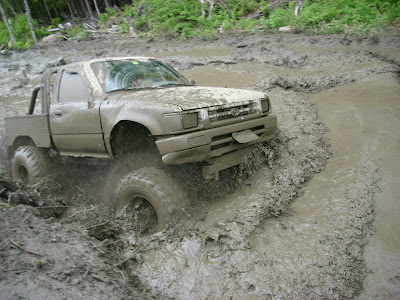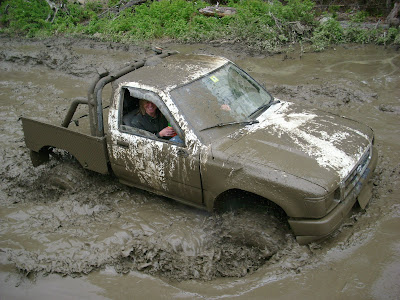Your stuck. Now what do you do? Call Uncle Marve to bring his old Farmall and pull you out. Maybe, but walking out eight miles to the nearest phone doesn't sound like all that much fun. A winch can be a very valuable thing to have, especially at times like this.
Most of the mud bogging that I do is at some kind of event, and there are provisions to get you unstuck, but if you do any trail riding, a winch can be indispensable.
There are other tools such as chains, tow straps (which I prefer way more than chains), come alongs and handy man jacks, but the winch can usually do the work of all of these.
Choosing The Right WinchI suppose the biggest determining factor in winch selection is budget, but having an underpowered winch can be about as valuable as no winch, especially when trying to free a truck mired to the doors in gooey mud.
Ideally your winch should be rated a to pull twice what your truck weighs, but for a full size truck, an 8000# winch is a minimum.
Electric winches are less complex than hydraulic winches, but that does not mean that installation is easy. Care should be taken when fabricating winch mounting brackets, and if your not sure about your skill in metal fabrication, then hire someone to do it for you. Most friends can be bribed into helping, and you probably know already how much beer it is going to take, just be sure to give it to him after the fab work is done.
If you can't get the help, buy a winch mounting bumper. They look cool, and winch companies actually spent good money designing them for proper fit and function.
Electric winches come with two types of motors, permanent magnet and series wound. Permanent magnet motors draw less amperage, but are less durable and not as tolerant to heat. For light duty winching, permanent magnet motors are fine,but series wound motors are better for heavy duty applications.
Winches draw huge amounts of power under load, sometimes reaching peaks of 475 amps. A single battery will be quickly drained from continuous high amp draw. A typical stock alternator puts out around 65 amps to 100 amps, and some industrial alternators can put out up to 200 amps. A second battery makes good sense, and not a $49.00 Walmart battery.
A typical automotive battery can stand up to repeated deep discharges, and a deep cycle battery often does not carry the cranking power for cold weather starting. A good choice is marine batteries or spiral batteries such as the Optima batteries.
Two batteries wired in parallel with a good 100 amp or better alternator will really help in tough winching situations, but careful attention has to be paid to battery voltage and alternator duty cycle. When voltages drop below 10.5, winch motor life is seriously compromised, and most alternators have a duty cycle in the 60% range.
Duty cycle is the relationship between operating time and the resting time of an electric motor. Duty cycles are figured on ten minute intervals, so a 60% duty cycle would mean six minutes of work followed by four minutes of rest. Over working an alternator by exceeding duty cycles is a sure way to burn it up.
Power supply lines for winch should be at least 1/0, and I would use 2/0 or 3/0 to reduce voltage drop. Make secure connections at the battery, and the ground wire has to be as heavy as the supply side. I recommend running the ground straight to the battery as well. Cables tying two batteries together should also be the same size as the smallest cable. Be sure to route all wires safely away from sharp corners and protect from chafing. If a supply line shorts to ground, its a good chance you will have to call your insurance company for fire replacement of your truck.
To get a good idea of how much power will potentially be going through these cables, think of a welder. To weld half inch steel plate, a welder will require 25 volts at 120 amps. To weld quarter inch steel, the numbers are around 19 or 20 volts at 100 amps.
If you make provisions to relocate your winch to the back of your truck, then some kind of quick disconnect is necessary. You can use the two pole quick disconnect such as these:
But for the larger cables such as 1/0 and larger, I prefer welder cable style connectors.
Use dielectric grease for connections, and make sure all contact points are clean. Corrosion raises resistance, and causes voltage drop, translating into loss of performance.
WinchingIt is a good idea to have leather gloves handy when winching. The cable spurs that eventually rise up on all cable are very sharp, and can reek havoc on your hands. If possible, stretch out as much cable as you can. Winches lose a percentage of their pulling power, and raise current draw, with every wrap of cable.
Never wrap a winch cable around a tree and hook back into the cable. First, the hook can damage the cable, and the cable will damage the tree, possible becoming lodged into it. Use a tree saver strap. When pulling, it is a good idea to drape a coat or winch blanket over the cable. A broken cable can break windshields and cause severe injury, and a few simple precautions can go along ways toward turning a situation bad.
A winching kit is a good idea. This consists of at least a pair of gloves, a winch blanket, a tree saver strap, and a snatch block. You can add a chain and various clevises.
A snatch block can be indispensable. It doubles the pulling power of your winch when pulling back to yourself. When pulling some one else, it can be used to redirect the winch cable when you can't line up for a direct pull.
If you are trying to pull someone heavier than yourself, or someone that is heavily mired, it will be necessary to anchor your truck to a tree or another vehicle. Use care when anchoring, as there will be as much tension on your anchor point as on the winch cable.
Never hook to a tow ball!! When they break, they are deadly projectiles.
A winch can save you from a long walk out of the woods. It can also be used for work style pulling, all it really requires is common sense and a little research to learn more.




















 The sun went down and the bonfire was lit, and another great time was had by all. Did I mention this sport freakin' rules.
The sun went down and the bonfire was lit, and another great time was had by all. Did I mention this sport freakin' rules.












